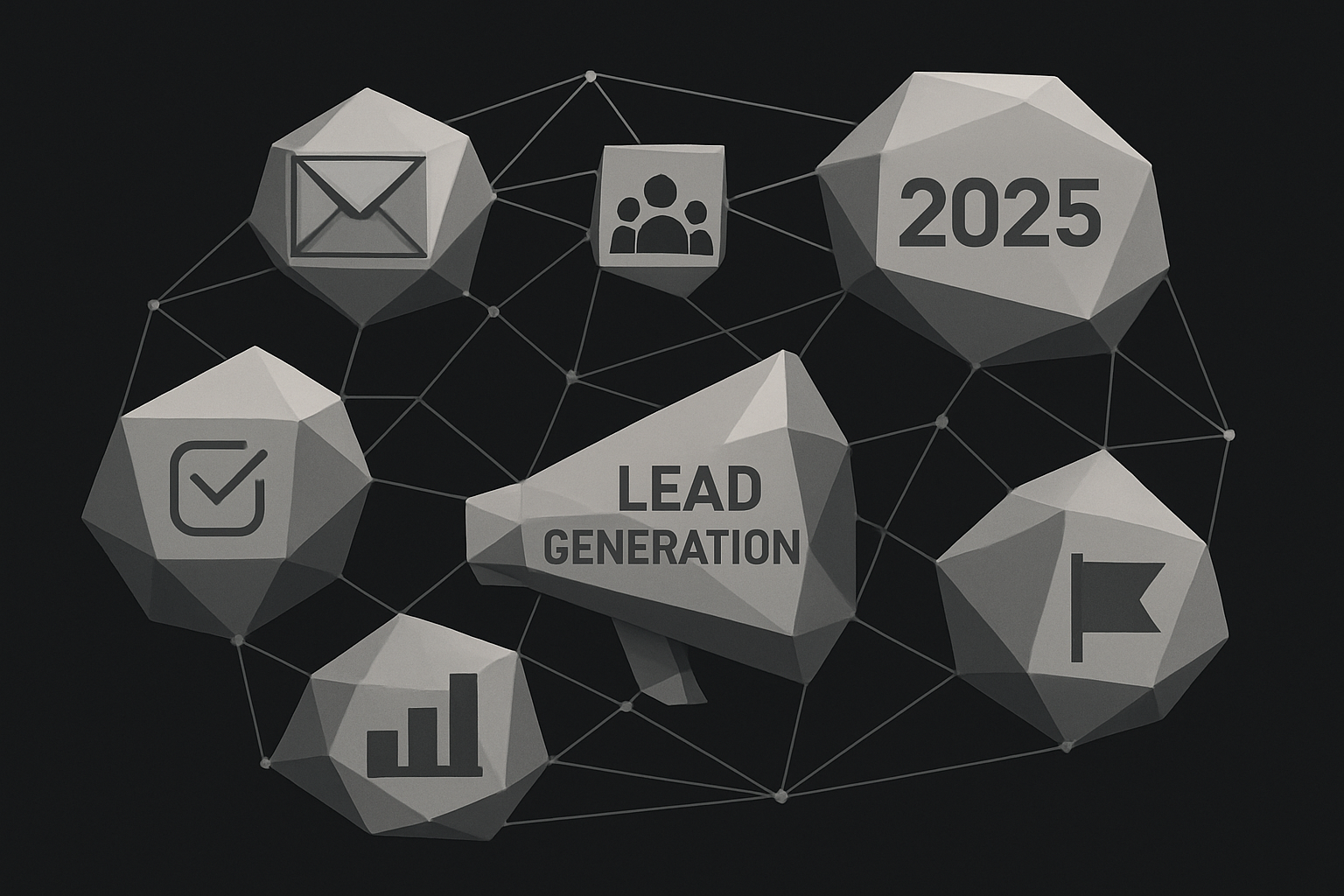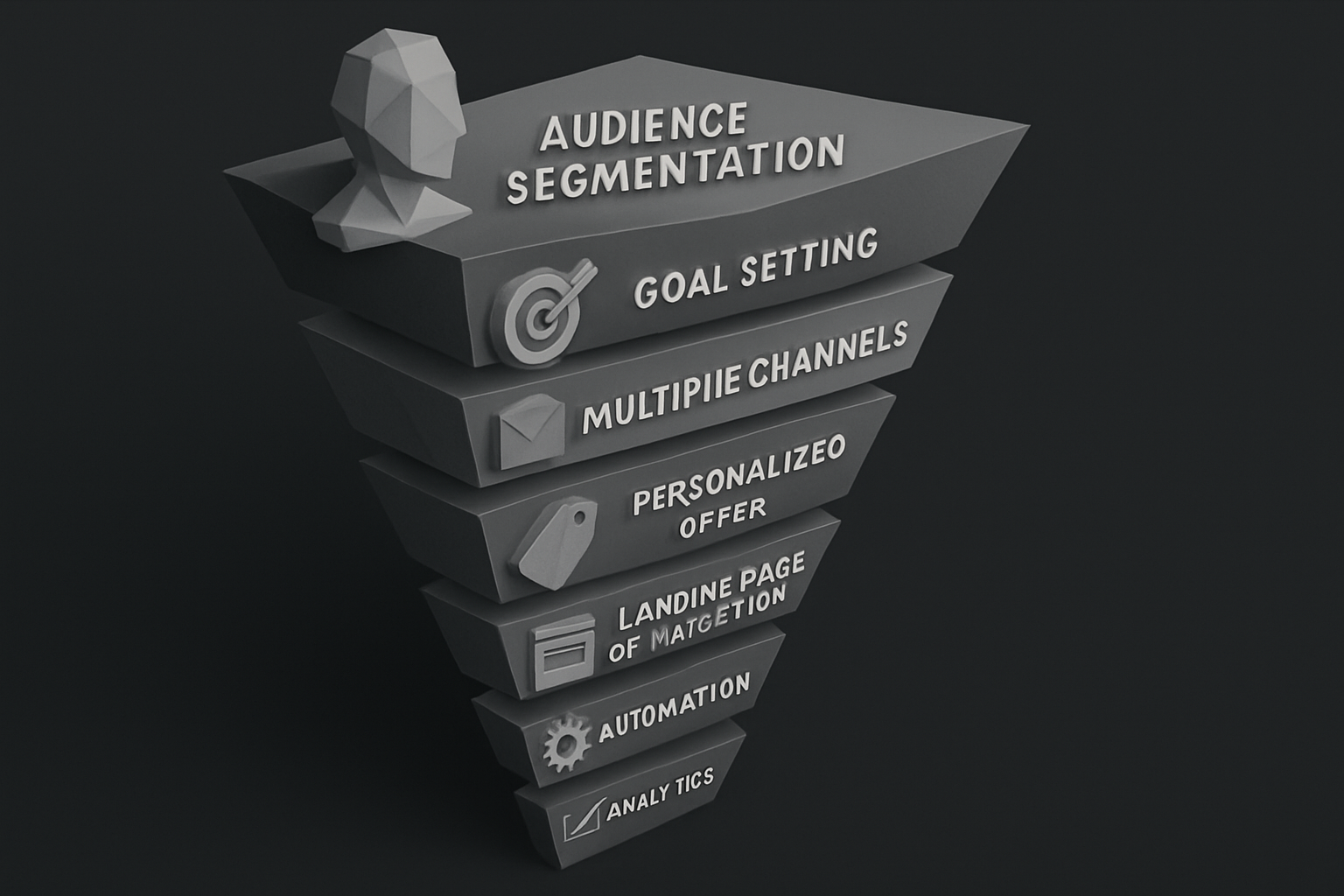Is your lead generation strategy ready for the rapidly evolving landscape of 2025? With digital competition at an all-time high, the rules are shifting—are you prepared to stay ahead or risk falling behind?
This comprehensive guide breaks down the latest best practices, frameworks, and actionable steps to help you build a lead generation strategy that consistently delivers high-quality leads. Discover how to align your marketing and sales teams, leverage cutting-edge tools, and maximize your ROI in today’s competitive environment.
We’ll cover everything from the fundamentals of lead generation and lead qualification to the most effective tactics, channels, and advanced trends shaping the future. Dive in and future-proof your approach for 2025.
Understanding Lead Generation in 2025
The digital landscape is evolving fast, and so is the meaning of an effective lead generation strategy. To stay competitive in 2025, it’s vital to grasp how lead generation is changing, why it’s critical for growth, the main challenges ahead, and which metrics matter most.

The Evolving Definition of Lead Generation
Lead generation is no longer just about casting a wide net. In 2025, a successful lead generation strategy means identifying and nurturing the right prospects through hyper-personalized, data-driven tactics.
B2B and B2C approaches now differ more than ever, with B2B marketers zeroing in on high-value decision makers and B2C teams focusing on micro-segments. The marketplace is crowded, and digital noise makes it tough to stand out. According to LinkedIn’s B2B Marketing Benchmark, lead generation is the top budget priority for marketers—so alignment between marketing and sales is crucial for defining what a qualified lead looks like.
Why Lead Generation Matters for Business Growth
At its core, a robust lead generation strategy fuels your sales pipeline and directly impacts revenue growth. The true value lies in balancing lead volume with quality—more leads don’t always mean more customers.
If your process isn’t efficient, you risk wasted spend and low conversion rates. Companies that invest in strong lead qualification consistently achieve better ROI. Nurturing leads is equally important; without follow-up, even the best prospects may slip away. Ultimately, a well-executed strategy ensures every marketing dollar works harder.
Key Lead Generation Challenges in 2025
With competition intensifying and digital channels overflowing with content, a lead generation strategy faces more roadblocks than ever. Stricter data privacy laws limit how marketers collect and use information, while ad fatigue causes engagement rates to slip across traditional platforms.
To overcome these hurdles, marketers must embrace omnichannel tactics and deliver seamless user journeys. According to B2B Lead Generation Statistics 2025, the effectiveness of purchased lead databases is dropping fast, pushing brands to adopt smarter, more ethical approaches. Staying agile and adaptive is a must.
Essential Lead Generation Metrics and KPIs
You can’t improve what you don’t measure. Every lead generation strategy should track core metrics like cost per lead (CPL), lead-to-customer conversion rate, and lead quality score. Distinguishing between Marketing Qualified Leads (MQLs) and Sales Qualified Leads (SQLs) is vital for pipeline health.
Modern attribution models help pinpoint which channels drive results, while advanced lead scoring boosts sales and marketing alignment. Companies that regularly review and optimize these metrics consistently outperform their competitors. Stay data-driven and refine your approach for lasting success.
Lead Qualification: Turning Prospects into Quality Leads
Converting prospects into qualified leads is the backbone of any lead generation strategy. Without a solid qualification process, even the most impressive pipeline can fall flat. Let’s break down the essential frameworks and models that help you separate high-potential leads from the noise.

Lead Scoring and Qualification Frameworks
Lead scoring is the foundation of a modern lead generation strategy, assigning values to prospects based on how likely they are to convert. Factors like demographics, firmographics, behavior, and engagement are all in play. Traditionally, this process was manual, but automation is now transforming the game.
AI-driven lead scoring relies on predictive analytics and real-time data, enabling faster, more accurate prioritization. For example, LinkedIn and its partners offer automated scoring solutions that help marketers focus on high-value prospects. To dive deeper into the impact of automation and AI, check out AI in Lead Generation Strategies. Ultimately, better scoring means more personalized outreach and higher conversion rates.
Building and Using Buyer Personas
A robust lead generation strategy starts with detailed buyer personas. These profiles capture critical information—industry, company size, job function, and key pain points—helping teams qualify leads with precision.
Personas act as the baseline for evaluating if a lead is a good fit. SaaS companies, for instance, often tailor their lead generation strategy to reach specific roles within target organizations. The result? Increased lead quality and campaign relevance. When you know exactly who you’re targeting, every message and offer becomes more impactful.
Behavioral and Action-Based Qualification
Modern lead qualification goes beyond static data. Today’s lead generation strategy uses behavioral signals—think form submissions, downloads, and webinar attendance—to gauge buying intent. Tracking every digital touchpoint across channels is essential for building a complete lead profile.
Tools like LinkedIn Conversation Ads now allow leads to self-qualify, giving you real-time insights into prospect interest. By customizing follow-up based on a lead’s actions, you can boost engagement and move prospects through the funnel more efficiently.
Popular Lead Qualification Models (BANT, etc.)
Classic frameworks like BANT—Budget, Authority, Need, Timeline—remain staples in any lead generation strategy. However, many organizations are developing industry-specific or custom criteria to reflect their unique sales cycles and buyer journeys.
Alignment between sales and marketing is critical for setting qualification thresholds. Companies using unified criteria often see reduced friction and smoother handoffs. Remember, the most effective lead generation strategy involves continuously refining your qualification process as market conditions and buyer behaviors evolve.
Step-by-Step Lead Generation Strategy for 2025
Building a successful lead generation strategy in 2025 requires a structured, data-driven approach. Follow this step-by-step framework to attract, qualify, and convert high-quality leads—no matter how fast the digital landscape shifts.

Step 1: Define Your Ideal Customer Profile and Segmentation
The first step in any lead generation strategy is to pinpoint your ideal customer profile (ICP). Start by conducting thorough market research to identify which segments offer the highest value.
Leverage demographic, firmographic, and behavioral data to craft detailed ICPs. Use CRM insights and analytics to refine segmentation over time. For example, a B2B software company might focus its lead generation strategy on decision-makers in finance or healthcare.
Effective segmentation ensures your efforts are targeted, making every subsequent step more efficient and impactful.
Step 2: Set Clear Goals and KPIs
A results-driven lead generation strategy is built on measurable objectives. Align your goals with overall business targets—do you want more leads, better quality, or higher conversion rates?
Establish KPIs such as lead volume, conversion rates, cost per lead, and lead quality scores. For instance, LinkedIn reports that lead generation accounts for 36% of B2B marketing budgets, highlighting its strategic importance.
Review your progress regularly, and adjust your lead generation strategy as performance data rolls in.
Step 3: Select the Right Lead Generation Channels
Not all channels deliver equal results. The most effective lead generation strategy evaluates where your audience is most active—whether that’s social media, PPC, content marketing, events, or webinars.
Prioritize channels based on ROI and audience behavior. For example, LinkedIn, webinars, and gated assets are top-performing B2B tactics. Embrace an omnichannel approach to maximize reach and adaptability.
Test new platforms, but always ensure they align with your overall lead generation strategy.
Step 4: Develop Compelling Offers and Lead Magnets
Your lead generation strategy needs irresistible offers to capture attention. Create high-value gated content such as eBooks, whitepapers, or checklists.
Offer webinars, free trials, demos, or personalized assessments tailored to each buyer persona and funnel stage. Companies that provide enticing incentives see higher engagement and form completion rates.
For more inspiration, explore Building digital products for profit, which details how digital products serve as powerful lead magnets.
Step 5: Optimize Lead Capture and Conversion Paths
Smooth, user-friendly capture is vital for any lead generation strategy. Use short website forms—ideally 3–5 fields—to reduce friction. Ensure landing pages are mobile-optimized and quick to load.
A/B test form layouts, CTAs, and incentives for the best results. Simplified forms can dramatically increase submission rates. For expert tips, check out this guide on product landing page optimization to boost your conversion paths.
Step 6: Implement Marketing Automation and CRM Integration
Automation is the backbone of a scalable lead generation strategy. Automate lead capture, scoring, and nurturing to increase efficiency and reduce manual effort.
Integrate your marketing automation tools with your CRM for seamless data flow and fast sales handoff. AI-powered automation can qualify leads in real time, ensuring no opportunity slips through the cracks.
The result? Faster response times and improved alignment between marketing and sales teams.
Step 7: Measure, Analyze, and Iterate
Continuous improvement is essential for a high-performing lead generation strategy. Regularly track campaign performance, lead quality, and channel effectiveness with robust analytics.
Identify bottlenecks and double down on top-performing tactics. Update your lead generation strategy based on actionable data insights.
Companies that embrace a culture of measurement and iteration consistently achieve higher ROI and outpace their competitors.
Top Lead Generation Tactics and Channels for 2025
Staying ahead with your lead generation strategy means knowing which channels and tactics will drive the most qualified leads. In 2025, digital noise and rising competition make it essential to invest in approaches that cut through the clutter. Let’s break down the top methods fueling high-performing strategies this year.

Social Media Lead Generation
Social platforms remain a cornerstone of every lead generation strategy. LinkedIn, Facebook, and Instagram offer both organic and paid tools to reach targeted audiences. In 2025, expect even more advanced lead gen forms that streamline data collection, especially on LinkedIn for B2B campaigns.
Video content and interactive posts can boost engagement, making your brand memorable. Don’t overlook social proof—employee advocacy and user testimonials add credibility to your outreach. The key? Test different content types and formats to see what resonates with your ideal prospects.
Content Marketing and Gated Assets
Educational, high-value content is still king in any effective lead generation strategy. Gated assets—like eBooks, whitepapers, and resource libraries—entice users to share their contact information in exchange for actionable insights. Dynamic landing pages personalize content for each visitor, improving conversion rates.
SEO optimization ensures your content reaches the right audience at the right time. For a deeper dive into essential tools that support content-driven strategies, explore these best digital marketing tools. Personalization, paired with robust analytics, helps you refine offers and maximize results.
Webinars, Virtual Events, and Live Streams
Webinars and virtual events have become must-haves for a modern lead generation strategy. Hosting live sessions allows you to capture leads through event registrations while showcasing expertise in your field.
Integration with CRM systems enables instant follow-up and nurturing. Promote your events across social media and email to maximize attendance. Features like interactive Q&A and live polls boost engagement and qualify leads based on participation.
Email Marketing and Nurture Sequences
Email remains a powerful pillar of any lead generation strategy. Building segmented, opt-in lists ensures you’re reaching prospects who want to hear from you. Automated nurture sequences—triggered by user behaviors—guide leads through the funnel with personalized messaging.
Personalization is key: tailor content based on persona, interests, and stage in the buyer’s journey. Always stay compliant with evolving privacy laws like GDPR and CCPA to maintain trust and deliverability. Well-designed nurture flows can significantly increase conversion rates.
Paid Advertising and PPC
A robust lead generation strategy leverages paid advertising to reach audiences actively searching for solutions. PPC campaigns on Google and social platforms allow for precise targeting by demographics, interests, and intent.
Keyword research identifies high-converting terms, while retargeting strategies help recapture visitors who didn’t convert initially. Always monitor your cost per lead and optimize ad creatives for better ROI. Regular testing and data-driven adjustments keep your campaigns efficient and effective.
Referral Programs and Customer Advocacy
Don’t underestimate the power of referrals in your lead generation strategy. Satisfied customers are often your best advocates, bringing in leads that convert faster and at higher rates.
Incentivize referrals with structured programs—offer rewards or recognition for successful introductions. Showcase testimonials and case studies to build trust with new prospects. Track referral performance to identify your most effective advocates and continually refine your approach.
Lead Nurturing and Conversion Optimization
Nurturing leads and optimizing for conversion are the backbone of any high-performing lead generation strategy. In 2025, success depends on delivering timely, relevant, and personalized experiences that move leads smoothly through the funnel.
Personalization and Segmentation in Nurturing
Personalization is no longer a nice-to-have—it’s a must for any lead generation strategy that aims to boost conversions in 2025. Segment leads by persona, behavior, and funnel stage to ensure each touchpoint is relevant.
Use dynamic content and adaptive email campaigns to speak directly to each segment’s needs. For example:
- Send tailored offers based on previous interactions.
- Adjust messaging for decision-makers vs. influencers.
- Leverage CRM data for highly targeted follow-ups.
Personalized nurturing increases engagement rates and helps move leads closer to a buying decision, making your lead generation strategy more effective.
Multi-Touch Lead Nurturing Workflows
A single email won’t cut it anymore. High-performing lead generation strategy workflows use multiple touchpoints—email, social, retargeting ads, and even SMS—to guide leads through the funnel.
Consider this multi-touch approach:
- Initial welcome email with a valuable resource
- Follow-up on social with retargeting content
- Timely webinar or demo invite
- Nurture series based on engagement
Industry data shows multi-channel nurturing outperforms single-channel by 2x. Timing and frequency matter, so map out your workflow to keep leads engaged without overwhelming them.
Sales and Marketing Alignment for Conversion
Alignment between sales and marketing is vital for a seamless lead generation strategy. Define clear criteria for Marketing Qualified Leads (MQLs) and Sales Qualified Leads (SQLs), then ensure both teams agree on the thresholds and handoff process.
Maintain regular communication and feedback loops to refine qualification. Use shared dashboards for transparency and performance tracking. When sales and marketing work in sync:
- Lead leakage is minimized.
- Conversion rates improve.
- Accountability is shared.
This alignment ensures every qualified lead is followed up with at the right time, maximizing the impact of your lead generation strategy.
Optimizing for Conversion: A/B Testing and UX
Continuous optimization is the secret weapon of a successful lead generation strategy. Test landing pages, forms, CTAs, and email sequences to discover what resonates with your audience.
Use analytics to pinpoint drop-off points and refine user experience. Simplified forms, compelling CTAs, and clear messaging all contribute to higher lead-to-customer rates.
For foundational conversion strategies that complement your lead generation strategy, learn how to sell online to further maximize results. Embrace a culture of ongoing experimentation for lasting growth.
Advanced Trends and Best Practices in Lead Generation
The landscape of lead generation strategy in 2025 is being reshaped by advanced technology, evolving regulations, and rising expectations for seamless customer experiences. To secure a competitive edge, businesses must embrace new tools and best practices that directly impact how leads are captured, qualified, and converted.
AI and Automation in Lead Generation
AI is revolutionizing the lead generation strategy by enabling smarter, faster, and more accurate targeting. Automated lead scoring, predictive analytics, and AI-powered chatbots now play a vital role in qualifying prospects and engaging leads in real time. For instance, Meta's ambitious push toward fully automated advertising highlights how AI will drive the future of marketing—see Meta's AI-Driven Advertising Plans for details.
Adopting these tools allows businesses to scale their lead generation strategy efficiently while focusing human effort where it matters most. As automation matures, expect even more personalization and timely responses, keeping your pipeline both full and high quality.
Data Privacy, Compliance, and Trust
With stricter regulations like GDPR and CCPA, data privacy is a core pillar of any lead generation strategy. Building trust starts with transparent data collection and clear opt-in processes. Companies that prioritize privacy not only avoid hefty fines but also see higher rates of form completion and lead engagement.
Key practices include:
- Publishing easy-to-understand privacy policies
- Using double opt-ins for email signups
- Regularly reviewing compliance as laws evolve
A trustworthy lead generation strategy reassures prospects and strengthens your brand’s reputation in a crowded digital world.
Omnichannel and Integrated Experiences
Today’s buyers expect a seamless journey across all touchpoints. An effective lead generation strategy leverages omnichannel tactics—integrating web, mobile, email, social, and even offline channels into a cohesive experience. Centralized data and unified messaging help track leads at every stage, ensuring no opportunity slips through the cracks.
Top benefits:
- Higher lead engagement rates
- Consistent brand experience
- Improved attribution and ROI
Businesses that excel at omnichannel integration see their lead generation strategy outperform single-channel efforts by a significant margin.
Measuring Success and Continuous Improvement
A data-driven lead generation strategy relies on advanced analytics and robust attribution models to measure what’s working—and what’s not. Regularly reviewing KPIs such as cost per lead, conversion rates, and lead quality scores is essential for ongoing optimization.
To stay ahead:
- Set clear benchmarks and review them quarterly
- Embrace a culture of testing and learning
- Leverage predictive insights from modern lead capture software—explore the Future of Lead Capture Software for emerging trends
Continuous improvement ensures that your lead generation strategy adapts to market shifts and technology advances, keeping you ahead of the competition.
Now that you’ve seen what it takes to build a winning lead generation strategy for 2025, why not put these best practices into action? Whether you’re just starting out or looking to refine your approach, taking that first step is often the hardest part. At CreateSell, we’re all about helping you move from selling your hours to building a digital product business that works for you—using proven frameworks and up-to-date tactics like the ones you’ve just read about. If you’re ready to take control of your lead generation journey, let’s do this together: Get Started.